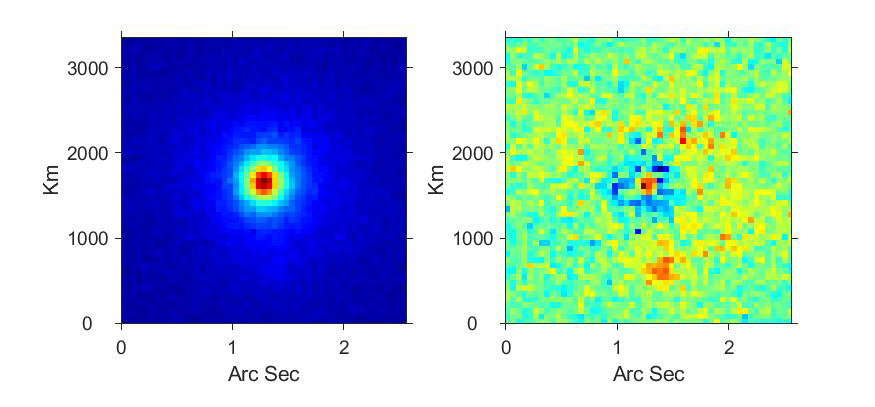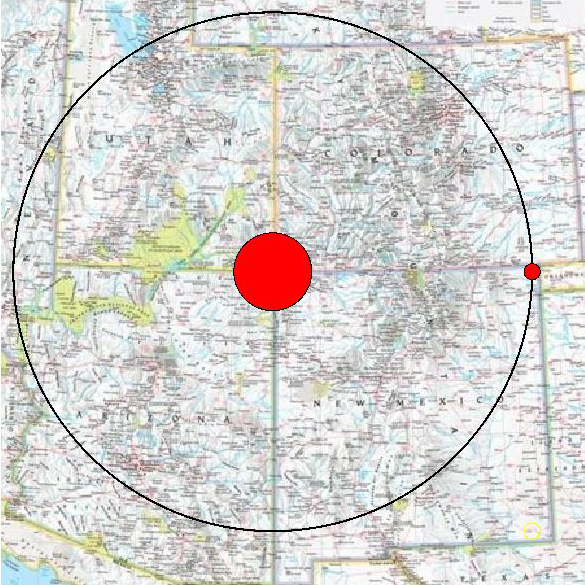AFRL detects moon around asteroid with smallest telescope yet
KIRTLAND AIR FORCE BASE, N.M. (AFRL) – On November 29, 2021, an Air Force Research Laboratory (AFRL) Starfire Optical Range (SOR)* telescope on Kirtland Air Force Base near Albuquerque, New Mexico, recorded an image of asteroid (22) Kalliope, and its natural satellite Linus. A confirming image was taken four nights later. What is unique about these observations is the small size of the telescope used, only 1.5 meters in diameter.
Normally the purview of large 8 to10-m diameter telescopes on mountain tops in Hawaii or Chile, asteroids are faint to begin with — and their satellites even fainter – orbiting very close to their parent. Detecting them requires large telescopes, since faintness limits are proportional to telescope mirror area and resolution is proportional to telescope diameter. In all cases, adaptive optics (AO) is required to defeat the turbulence of the atmosphere by making the point sources (stars) much smaller and brighter.
Also participating in studies of asteroids and their satellites is the rather small, by comparison, SOR 3.5-m telescope. This telescope, which had previously been the smallest telescope to image and follow an asteroid and its moon over months, uses AO and a sodium laser to produce an artificial or guide star as a point reference.** Now, the 1.5-m telescope, right next door to the 3.5-m, has the record after taking images using AO, but without a laser.
“It was tough closing the AO loop because Kalliope was so faint,” said Dr. Odell Reynolds, a senior engineer at the SOR. “We had to slow down the system correcting the wavefront, hoping that it would still keep up with the changing atmosphere.”
Scientists at the SOR were surprised and delighted that their smallest telescope captured the image.
“In the end, after fitting the dominant Kalliope as a Lorentzian point spread function, and then subtracting it, Linus just popped out,” exclaimed SOR astronomer Tanya Tavenner. “I couldn’t believe we imaged a moon around an asteroid with such a small telescope. It’s really a tribute to the observing and engineering skills of Odell.”
Tavenner was pessimistic that there was anything in the field other than Kalliope when she first reviewed the images.
“Linus was so faint next to the much brighter Kalliope that I missed it the first time around,” Tavenner said. “Kalliope is 63 times fainter than the naked eye limit, and Linus was found to be 23 times fainter still than Kalliope, and would be located within the spread of the point source for Kalliope produced by the atmosphere without AO.”
Dr. Mala Mateen, the principal investigator for the Closely Spaced Object program at the SOR, was excited about the image.
“This demonstrates that we can perhaps push high-contrast imaging to smaller telescopes in order to separate two close objects in space,” Mateen said.
The asteroid Kalliope resides in the Main Belt of asteroids between Mars and Jupiter, and is about 161 kilometers in diameter. Its satellite Linus, one of two known to orbit Kalliope, was discovered in 2010 with the Keck 10-meter telescope on Mauna Kea, Hawaii, and is about 34 km in diameter. Linus orbits Kalliope at a distance of 1100 km in 3.6 days.
*Starfire Optical Range factsheet: https://afresearchlab.com/technology/successstories/starfire-optical-range/
**See the link to learn more: https://www.abqjournal.com/2357213/searching-the-heavens-for-the-little-guys.html).

AFRL’s 3.5 meter telescope on Kirtland AFB, N.M. uses its laser to produce a guide star for a reference for adaptive optics, and previously held the record for the smallest telescope to image an asteroid’s satellite. The larger of the two domes to its left houses the 1.5 meter telescope, which now holds the record, without using a laser. (U.S. Air Force photo/Robert Fugate)

At left is an unprocessed image of the asteroid Kalliope with its satellite Linus not easily visible taken with the Air Force Research Laboratory’s Starfire Optical Range telescope at Kirtland Air Force Base, New Mexico on November 29, 2021 . At right, after fitting Kalliope as a Lorentzian and subtracting the model, Linus shows up in the residuals as a bright spot below where Kalliope was before subtraction. North is up and East is to the left. The scale in km is at the distance of the asteroid. (Image/Starfire Optical Range)

The Kalliope asteroid (large red dot), and it’s satellite Linus (small dot), and Linus’ orbit are shown over the Four Corners region of the Southwest United States. The Air Force Research Laboratory recorded an image of Kalliope and Linus, using AFRL’s1.5 meter telescope on November 29, 2021. (US Air Force Drawing/Jack Drummond)

Air Force Research Laboratory senior engineer Dr. Odell Reynolds with AFRL’s Starfire Optical Range telescopes in the background. Odell recorded an image of the asteroid Kalliope and its natural satellite Linus, using AFRL’s1.5 meter telescope on November 29, 2021 – a surprising achievement based on the small diameter of the telescope. (U.S. Air Force photo/Benjamin Herrera)
